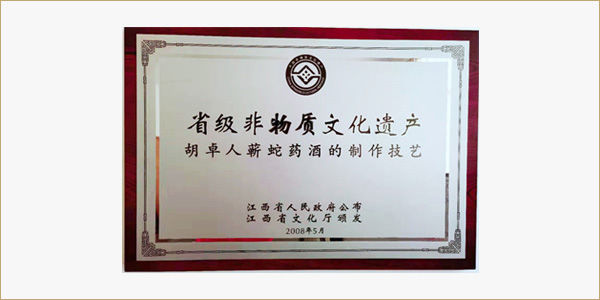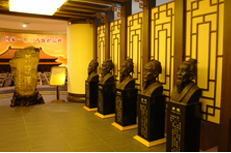
The production process of Hu Zhuoren's Qishe Medicinal Wine (second batch at the provincial level) has a long history of traditional Chinese medicine processing in Jizhou City. As early as the first year of Xianxiang in the Tang Dynasty (670 AD), there were multiple pharmacies in the city that could make their own paste, pills, and powder. The Hu Zhuoren Medicinal Liquor Bureau was founded in the late Ming Dynasty and has a history of more than 400 years. Its main product, Hu Zhuoren Qishe Medicinal Wine, penetrates bones and dispels wind, soothes muscles, and activates collaterals. It is a miraculous medicinal wine for treating rheumatism, numbness, quadriplegia, hemiplegia, joint pain, leprosy, and other diseases. Hu Zhuoren, the founder of the production process of Qishe Medicinal Wine, is the owner of Jizhou Hu Zhuoren Medicinal Wine Bureau. Its discovery originated from a beautiful legend that everyone believed to be true. It is said that in a certain year, Hu Zhuoren went to Guangdong to purchase medicinal herbs and stayed at an inn in Lingnan. She met a woman surnamed Chen who offered to sleep on her bed. Hu Zhuoren is a loyal and kind-hearted person. When he asked for the reason, he found out that Miss Chen had unfortunately contracted leprosy and was forced by her parents to go insane. The so-called 'letting go crazy' is a folk custom of transferring one's leprosy virus to another person through sexual intercourse and recovering oneself. Hu Zhuoren sympathized with Miss Chen's situation and promised to return to Jizhou for free medical treatment. One year later, Miss Chen poisoned her hair and begged all the way to Jizhou. Hu Zhuoren placed her in the backyard and treated her by boiling soup and medicine. However, three years have passed, and her illness has not improved. Hu Zhuoren is extremely anxious but helpless. Once, Hu Zhuoren went out to purchase medicinal herbs again, and the hired servants were already afraid of infection. After losing the supervision of their employer, they no longer took care of Chen, who was covered in pus, thin and ugly all over her body. One day, Miss Chen was both hungry and thirsty, and couldn't help but drink the dirty water from the water tank under the flower stand. I didn't expect that drinking this dirty water would make me feel better all over, so I went to drink it every day. Over time, a miracle occurred, and the abscess on Miss Chen's body gradually healed, and her body became much stronger. Hu Zhuoren returned and was surprised and confused to see that Miss Chen had no illness at all. After asking repeatedly, he learned that she had drunk dirty water from the backyard tank, so he went to investigate. Originally, the 'dirty water' in this jar was ordinary medicinal wine that was exposed under the flower rack. However, how could ordinary medicinal wine have such miraculous effects? Hu Zhuoren scooped up the wine from the vat and found a snake soaking in the bottom of the vat. This discovery made Hu Zhuoren understand the mystery behind it. So, he used traditional Chinese medicinal herbs such as Qisnake and golden scorpion as the main formula to make Qisnake medicinal wine with the functions of penetrating bones, dispelling wind, and relaxing tendons and activating collaterals. Hu Zhuoren's Qishe Medicinal Wine is very strict and meticulous in the selection of raw materials and the preparation process. The ratio of these medicinal herbs is very particular, and the preparation methods of different herbs are also different, including steaming, salt frying, vinegar pickling, and even fire forging, which can be described as various and peculiar. After all the traditional Chinese medicine materials are prepared, they are mixed and crushed into coarse powder, placed in pottery, soaked in 50 degree Baijiu, made of rice straw, covered with cotton cloth, sealed, and stirred once a day. After more than a month, the filter residue is pressed, clarified, the supernatant is combined with the filtrate, added with brown sugar, stirred and dissolved, and then filtered again after standing to obtain the finished medicinal wine.













